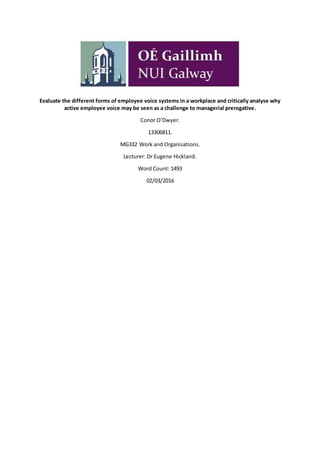
Work and Org's Essay. Employee voice
- 1. Evaluate the different forms of employee voice systems in a workplace and critically analyse why active employee voice may be seen as a challenge to managerial prerogative. Conor O’Dwyer. 13306811. MG332 Work and Organisations. Lecturer: Dr Eugene Hickland. Word Count: 1493 02/03/2016
- 2. SignedPlagiarismStatement. I herebycertifythatIunderstandwhatplagiarismisandthat thisessayisentirelymyownwork. Neitherthe paperinitsentiretynorpartsthereof have beenpublishedelsewhere ineitherpaperor electronicformunlessindicatedthroughreferencing. Signed:
- 3. Employee Voice hasbecome ahottopicinbusinessinrecenttimes.The sharpdeclineinTrade Unionrepresentationwithinthe workplace coincidingwiththe introductionof lawssuchasthe E.U InformationandConsultationDirective 2002, describedby Dundon(2007) as givingemployeesa legal rightto be informedandconsultedshouldtheyoptin,haspromptedcompaniestomake employeevoice mechanismsapart of theirbusiness. There are numerousdifferentmechanismsof implementingemployee voicewithinabusinesswhichcanbe dividedintodirectandindirect mechanisms andwill be lookedatnextinthe essay.There isalsoa multitude of termsusedinplace of voice suchas involvementorengagement, because of thisitishardto finda universal definition, however,Dundon(2007) offersa gooddefinitionbywayof Boxall andPurcell (2003),definingit as “a whole varietyof processesandstructureswhichenableandattimesempoweremployees, directlyandindirectly,tocontribute todecisionmakinginthe firm.”Sovoice isessentiallygiving employeesasayin the runningof the company,and Blyton(2011) feelsthatitfostersa commonalityof interestsandgreaterco-operationbetweenworkersandmanagement.Howeverit isapparentthat voice mechanismscanindeedhinderthe managerialprerogative,somethingwhich will be discussedlaterinthe essay. Indirectformsof Employeesvoice involve employee representativesconsultingwithmanagement overissuesinthe business.Fromanemployee’sperspective,these canbe a lesseffectiveform.The mostobviousformof indirectvoice isTrade Unions,Noon(2007) identifiesthatwhenemployees joina union,theyrecognise thattheirinterestsare notidentical totheiremployers.Ingranting unionrecognition,Noonalsonotesthatthe companyagreestotreat themas the representative voice of theiremployeesandnegotiationsare done viacollective bargaining.Howeverthere isno obligationonthe employertorecognise the union,thisisnotedbyBlyton(2011) whoadds that some unionformsof representationcanbe a hollow shell andineffective.Anotherformof indirect voice isqualitycircles,describedbyProcter(2000) as temporary,voluntarygroupsconcernedwith findingimprovementstoworkprocesses. Theyare agoodway for managementtogaininsightinto the creativityof theiremployeesandattempttoattainnew ideasforthe business.QualityCircles are oftencriticisedthoughdue totheirdegree of influence,Procteraddsthatthey’re the mostdilute formof employeevoice, whilstBlyton(2011) adds that managementonlymonitorsengagement fromthe side-lines.Fromthe perspectiveof management,indirectformsof voice maywell optimum for themintermsof preservingtheirprerogative astheycancontrol what isdiscussedwith employeesandoften,the final decisionisalwaysmade bythem. Directformsof employeevoice involvesdirectcommunicationbetweenemployeesand management. Dundon(2007) highlightsthe biggestdevelopmentinemployeevoice inrecenttimes has beenashiftfromindirecttodirectforms.Despite the termsbeingusedinplace of employee voice,participationandinvolvementare different.Involvementisthe weakerformof voice,defined by Dundon(2007) as solicitingthe views,opinionsandco-operationof employeeswithoutsharingof powerindecisionmaking. Whilstparticipationinvolves sharingpowerbetweenemployeesand managementinthe makingof jointdecisions.Thisisclearlymore extensiveanddirectandWilkinson (2011) feelsinvolvementisanecessaryprecursorforparticipation.A seconddirectformisteam- working,seenbyProcter(2000) as more extensivethanotherforms,beingpersonal,allowing employeesagreaterdegree of influenceandcontrol overwork.Thisistrue,team-workallows workersgreaterautonomyandmore communication withbothco-workersandmanagement. Employee engagementisthe mostcomplete type of directvoice,definedbyDundon(2007) as when people employthemselvesphysically,emotionallyandcognitivelyintheirjobtowardsorganisation goals.This givesemployees avoice inthe organisationand encouragesthemtomake itpart of their life.Guest(2014) explainsitsuse incompanieswitharesource basedview,where theyseetheir humanresourcesas key toleverage competitiveadvantage.Dundon(2007) highlightsleadership,
- 4. engagedmanagers,goodvoice mechanismsandintegrityas keydrivers of engagement.Directforms of voice are oftenbetterfromthe perspective of the employeeastheyhave a biggersayinthe company,formanagementhowever,some directforms,especiallythose like engagement,require themto give upsome decisionmakingpower,whichmayaffecttheirprerogative. Dundon(2007) highlightsanevaluative frameworkwhichcanbe usedto testthe thoroughnessand effectivenessof the voice mechanismswhichexistwithinanorganisation.The areasinwhichit’s examinedare depth,scope,level andform.Depthdescribesthe extenttowhichemployeesshare in decisionmakingwhilstscope isthe range of issuesonwhichtheyhave asay, these are oftenlinked. Level describesthe hierarchical level inthe orgat whichthe voice takesplace.Finally,formisthe type of voice methodused,whetherit’sdirectorindirect.Thisframeworkisveryuseful andcanbe usedbymanagementtodecide whattype of voice theywantto use dependingonhow muchpower theywantto relinquishtoemployees.Theymaywantavoice type witha shallow depthinorderto minimise challengestotheirprerogative. The BusinessDictionary.comdescribesmanagementprerogativeasmanagement’sunqualified authoritytoexercise itsdiscretionwithoutdiscussion.Implementingemployee voice inthe organisationcancertainlyhinderthisprerogative. The firstwayinwhichmanagement’sprerogative can be challengedbyemployee voice isthroughemployeeschallengingdecisions.Dundon(2004) noteshowvoice can be an articulationof dissatisfaction.Employeesmayvoice theirdispleasure with the actionsor decisionsof managementmeaningtheycouldgetverylittle done andnotgettodo the thingswhichtheywant.Noon(2007) alsomakeslightof how employees,throughvoice,will vent theirdissatisfactionwiththeirjobandtheirinvolvementindecisionmaking.Managementmayalso lose a degree of powerwithinthe organisationasaresultif implementingemployee voice mechanisms. Losingadegree of decisionmakingpowerwill come withsome formsof voice and mostcertainlywill hindertheirprerogative.Aspartof the informationandconsultationdirective, managementare requiredtoconsultonissuesregardingthe economicsituationof the organisation and work/contractual arrangements,Dundon(2007) arguesthat these are issuesthatmanagement wouldsee aswithintheirprerogative,especiallywhenthere’sanassumptiontheymustreachan agreementonthese.Managementcanalsoexperience alossof powerwhere theyhave implementedteamwork.The more independenceandautonomyallowedtothe teammaysee them make theirowndecisionsonaregularbasis,notrequiringthe inputof management.Thispointis backedby Procter(2000) whonotesthat whenteamsare givenresponsibilityformanaging disciplineandattendance,the distinctionbetweenmanagersandnon-managerscanbecome blurred.Thisisalsothe case withTrade Unions,Noon(2007) saysthat theyonlyexistbecause of an imbalance of powerbetweenemployerandemployee.A Unionsobjective istotake some of this powerawayfrom managementandgive ittoemployees. Voice can alsodothingsto helpmanagersinrunninga smoothandefficientorganisation.Employee voice hasbeenseentoimprove jobsatisfactioninemployees,Dundon(2004) notesthatvoice can be seenas helpingtoreduce exitandimprove employeebehaviour,makingemployeesmore loyal and committed.Havingadedicatedandcontentworkforce will have alotof benefitsfor managementone of whichmaybe a more productive organisation,highlightedbyWilkinson(2011) whofeelsitcouldleadtoincreasedproductivityandimprovedorganisational performance.Whilst there isno definitivewaytomeasure these benefitsitiseasytounderstandhow theycan arise. Withits array of differentformsandobviousgrowthinpopularityinrecenttimes,aconclusioncan be drawn that employee voice ishere tostayinthe modernorganisation.Employeesare,atthe end of the day,still the mostvaluable assetanorganisationhasandtheirwantto be heardin the organisationistoolarge to simplybe ignored.There isnodoubtthatvoice can challenge the
- 5. management’sprerogative,somethingthatisan obviousworryforall managers,andWilkinson (2011) saysthat voice doesn’thave toinvolve a“de jure sharingof authorityandpower”howeveras deeperandmore directformsof voice become more popularanddemanded,the realityisthat managersmay simplyhave agree togive upsome of theirprerogative inordertogainthe benefitsof implementingemployee voiceintheirorganisation.Whilstthese benefitsare not,as yet, ‘scientifically’proven,whichmayexplainsomeorganisationsreluctance toimplementvoice,the evidence thatalreadyexistsisenoughtoprove thatemployee voiceisoverall agoodthingforan organisationtoadopt.
- 6. References. Blyton.P,Heery.E, Turnbull.P(2011). Reassessing theEmploymentRelationship.New York:Palgrave MacMillan. BusinessDictionary http://www.businessdictionary.com/definition/management-prerogative.html Last accessed;01/03/16 Dundon. T, Rollinson. D(2007). Understanding EmploymentRelations.2nded.Maidenhead: McGraw-Hill Education. Dundon.T, Wilkinson.A,Marchington.M,Ackers.P. (2004). The Meanings andPurposesof Employee Voice.TheInternationalJournalof Human ResourceManagement.15(6). Guest.D. (2014). Employee Engagement:A Sceptical Analysis. Journalof OrganisationalEffectiveness Peopleand Perfomance.1 (2),p141-156. Noone.M, Blyton.P(2007). The Realities of Work. 2nd ed.Basingstoke:Palgrave. Procter.S, Mueller.F(2000). Teamworking.Basingstoke:Macmillan. Wilkinson.A,Fay.C.(2011). NewTimesforEmployee Voice. Human ResourceManagement.50(1), p65-74.